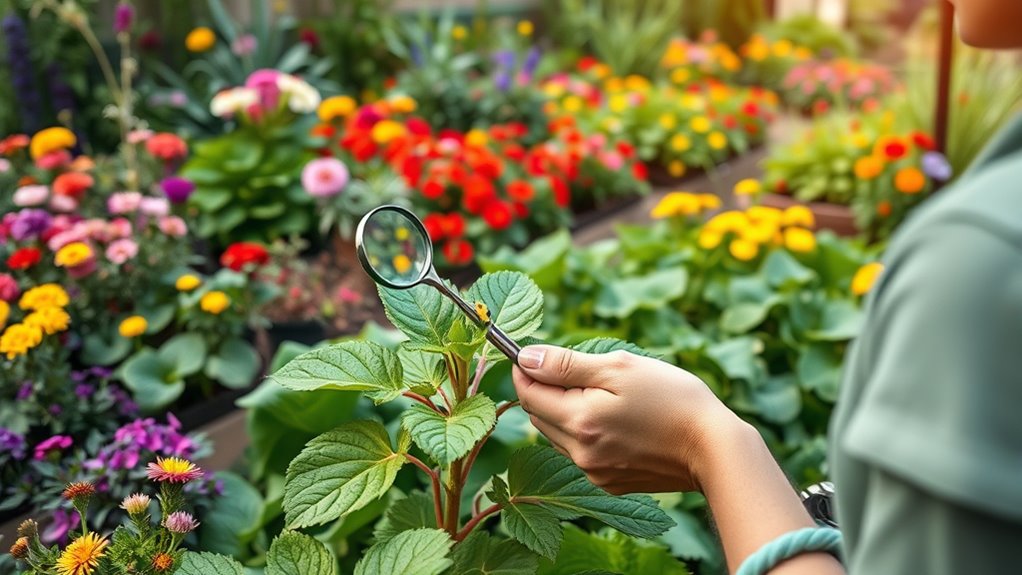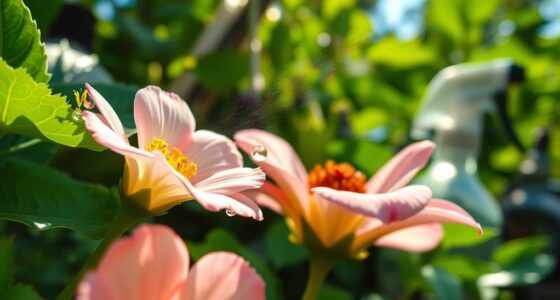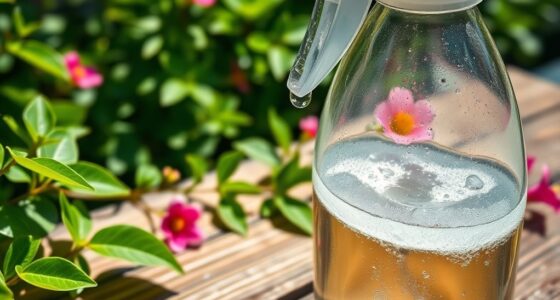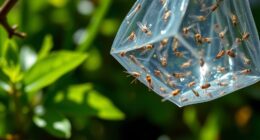Integrated Pest Management (IPM) is a practical approach that helps you control pests in your garden by combining different methods. It focuses on understanding your garden’s ecosystem and using natural predators, regular monitoring, and targeted techniques. By reducing chemicals and focusing on early detection, IPM promotes healthier plants and a more balanced environment. If you continue exploring, you’ll discover effective ways to implement IPM strategies and keep your garden thriving.
Key Takeaways
- IPM combines various pest control methods to minimize chemical pesticide use and promote ecological balance.
- It emphasizes regular pest monitoring to detect issues early and guide targeted interventions.
- Biological controls, like natural predators, are used to manage pests without harmful chemicals.
- Decision-making in IPM relies on monitoring data to determine when and how to act effectively.
- Overall, IPM supports sustainable gardening by protecting plants, reducing environmental impact, and saving resources.

Ever wondered how to control pests effectively without harming your garden or the environment? That’s where integrated pest management, or IPM, comes into play. IPM is a strategic approach that combines different methods to keep pest populations under control while minimizing the use of chemical pesticides. It’s about understanding your garden’s unique ecosystem and applying targeted techniques that work in harmony with nature. Central to this approach are biological controls and pest monitoring, which serve as the foundation for sustainable pest management.
Biological controls involve introducing or encouraging natural predators, parasites, or pathogens that naturally keep pests in check. For example, ladybugs can control aphid populations, while certain nematodes can target soil-dwelling pests. By leveraging these natural enemies, you reduce the need for chemical interventions, making your garden safer for beneficial insects, pets, and humans. It’s a proactive way to manage pests, focusing on maintaining ecological balance rather than just reacting to infestations. To make biological controls effective, pest monitoring is essential. Pest monitoring means regularly inspecting your plants for signs of pests or damage. This helps you catch problems early before they become severe, allowing you to act only when necessary. With consistent monitoring, you can identify which pests are present, how many there are, and whether they’re causing significant harm. This targeted approach prevents unnecessary treatments, saving you time, money, and reducing chemical use.
Monitoring also informs your decisions about when and how to introduce biological controls. If you notice a small aphid outbreak, releasing ladybugs early can keep the population from exploding. If pest levels are low, you might opt to wait and monitor rather than immediately applying a pesticide. This careful observation ensures that interventions are justified and precisely targeted. Additionally, pest monitoring can help you evaluate the effectiveness of your biological controls, giving you feedback on whether your natural enemies are working as intended or if adjustments are needed. Using these tools together creates a dynamic, responsive system where pest populations are managed naturally and sustainably. Incorporating integrated pest management strategies into your gardening routine not only protects your plants but also supports a healthy, balanced ecosystem in your garden.
Frequently Asked Questions
How Does IPM Impact Beneficial Insects in the Garden?
IPM positively impacts beneficial insects by prioritizing beneficial insect preservation and reducing chemical use. You’ll use non-chemical alternatives like biological controls and habitat enhancement, which protect helpful pollinators and predators. This approach minimizes harm to beneficial insects, ensuring they continue to control pests naturally. By focusing on targeted, eco-friendly methods, you create a healthier garden ecosystem, supporting beneficial insects and reducing the need for broad-spectrum pesticides.
What Are the Cost Differences Between IPM and Traditional Pest Control?
Sure, you could spend a fortune on traditional pest control, but let’s do a little expense analysis. IPM might seem pricier upfront, but its cost comparison shows long-term savings by reducing chemical use and damage. You’ll likely spend less overall, avoiding repeated treatments. So, while traditional methods drain your wallet quickly, IPM proves to be a smarter investment—less costly, more eco-friendly, and kinder to your garden.
Can IPM Be Used Effectively in Organic Gardening?
You can absolutely use IPM effectively in organic gardening. It involves using organic methods like beneficial insects, plant selection, and natural repellents, combined with pest monitoring to catch issues early. By carefully observing your garden and applying targeted, eco-friendly solutions, you keep pests in check without chemicals. This approach promotes healthy plants and a balanced ecosystem, making your organic garden more productive and resilient over time.
How Often Should I Inspect My Garden for Pests Using IPM?
You should perform pest monitoring regularly, ideally once a week, to catch issues early. Inspection frequency depends on your garden’s size and vulnerability, so during peak pest seasons, you might need to check more often. Look for signs like chewed leaves or discolored plants, and adjust your inspection schedule accordingly. Consistent pest monitoring helps you stay ahead of problems and apply targeted, effective control methods when needed.
Are There Any Specific Tools Required for Implementing IPM Strategies?
You don’t need many tools to implement IPM strategies. Monitoring tools like traps and visual inspections help you spot pests early. Biological controls, such as beneficial insects, require minimal equipment but need proper release and management. Keep a spray bottle or hand lens handy for close inspections. These tools help you stay proactive, reducing chemical use while maintaining a healthy garden. Regular monitoring and biological controls make IPM effective and eco-friendly.
Conclusion
By embracing integrated pest management, you’re like a skilled gardener tending a delicate balance—every action carefully chosen to protect your plants and the environment. It’s not just about controlling pests; it’s about nurturing a healthy, thriving garden. When you use IPM practices, you’re steering your garden away from harsh chemicals and toward sustainable harmony. Think of it as guiding your plants through a gentle dance, where every step promotes growth and resilience.









